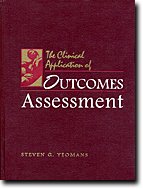|
|
The Clinical Application of Outcomes Assessment
Book Review
by
Jeffrey Kintish, DC
| Title: |
The Clinical Application of Outcomes Assessment |
| Author: |
Steven G. Yeomans, DC, FACO |
| Publisher: |
Appleton and Lange, 2000 |
| Type: |
Hardcover, 696 pages |
| Price: |
$89.95 |
| Part #: |
T-252 |
 Together with a large cast of contributors from a cross section of physicians and PhDs, Dr. Yeomans has written a text that is a must read for every chiropractor. I have never met a doctor who likes to write notes. It is time-consuming, tedious and among other things, takes your focus away from patient care. In this book, you will find a number of ways to make the task of documentation not only essential, but also easier. Together with a large cast of contributors from a cross section of physicians and PhDs, Dr. Yeomans has written a text that is a must read for every chiropractor. I have never met a doctor who likes to write notes. It is time-consuming, tedious and among other things, takes your focus away from patient care. In this book, you will find a number of ways to make the task of documentation not only essential, but also easier.
Five sections divide this text: Outcomes Assessment Overview; Subjective Outcome Assessment Tools; Objective Outcome Assessment Tools; Application of Outcomes Assessment to Clinical Practice; and Practical Reality: Commonly Asked Questions Regarding Outcomes Assessment. Each section begins with an overview and is subdivided into a number of chapters that expand on the topic presented. They are well-referenced and include plenty of graphs, pictures and tables for clarification. Each chapter ends with a conclusion that reviews the highlights and details. There are also blurbs throughout this text called "Clinical Tips" that provide the practitioner with additional insights.
Section one brings the reader up to speed with the basics of understanding the how and why of (and the need for) outcome measures. It is a foundational section that is referenced throughout the text. Section two is a discussion about objectively measuring patient complaints using pain forms and questionnaires. Section three is a great review of functional testing procedures the doctor uses to engage and measure the patient's subjective complaints objectively. Section four and five pull it all together and demonstrate through case study examples how to utilize these tools in practice. Information is provided about how to educate your staff, and office implementation procedures are reviewed. My favorite part of this book is found in the appendixes: You will find a gold mine of forms and tools you have probably never seen before, but that can be utilized in your practice immediately.
Dr. Yeomans work has been extremely positive, helping our profession as a whole and paving the road for enhanced clinical excellence for us all. In today's climate of managed care and accountability, the daily task of patient documentation is far different than in the past. I am convinced that if you use the tools presented in this text, you will enjoy your practice much more and gain clarity and objective evidence about your patients' progress. As we all know, basing clinical success on symptoms is an inaccurate method of measuring progress. Using the information and tools presented here, you will know when you have reached MMI [maximum medical improvement]. Clinical decision-making will be a breeze and your patients will know what they have gained through your treatment.
Dr. Kintish's Rating:
 10.5 out
of 10 10.5 out
of 10

|

|








